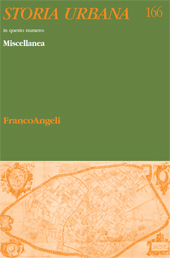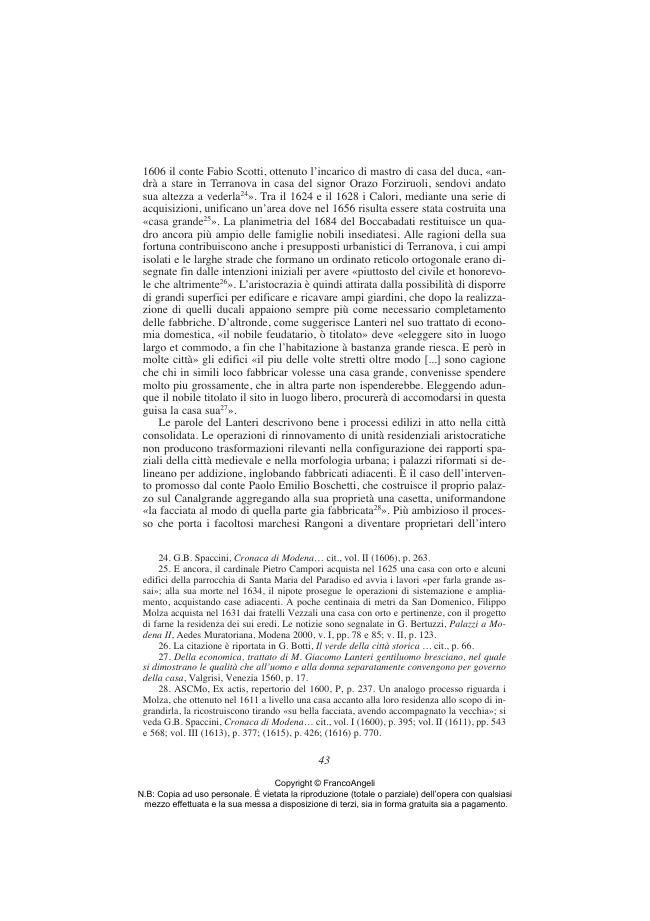Nuove gerarchie urbane per Modena capitale : il ruolo dell'aristocrazia nelle trasformazioni in città (1598 - prima metà XVII sec.)
P. 37-48
Con l'elezione di Modena a capitale del ducato Estense, un vigoroso fermento edilizio prende vita per adeguare la piccola cittadina al ruolo acquisito. Se noti sono gli interventi sulle fabbriche Estensi, il contributo indaga le conseguenze dell'arrivo dei duchi analizzando la riconfigurazione alla scala urbana di Modena attraverso una lettura sistematica degli interventi edilizi che le famiglie aristocratiche intraprendono a inizio Seicento, per assicurarsi il favore estense e accreditare le proprie ambizioni nella corte rinnovata. Le fabbriche ristrutturate e più spesso ampliate restituiscono interessanti indicazioni su alcuni aspetti architettonici che vanno connotando la capitale; ma soprattutto, rivelano l'introduzione di nuove gerarchie negli spazi urbani, dove la definizione della nuova residenza ducale sembra condizionare i cambiamenti.
L'indagine sistematica sulle residenze è condotta sulle fonti edite, attraverso lo spoglio circostanziato dei documenti d'archivio e sulle cronache cittadine che restituiscono la percezione delle trasformazioni più significative. I dati sono correlati tra loro, e interpretati anche in relazione alla loro ubicazione in città. Se le informazioni spesso frammentarie non permettono una interpretazione adeguata dei singoli episodi edilizi, la lettura integrata e comparata offre molteplici suggestioni per cogliere gli esiti di un fenomeno complessivo che contribuisce al riassetto della città. [Testo dell'editore]
With the election of Modena as the capital of the Este dukedom, an intense period of feverish construction began in order to adapt the small city to its new role. While the work carried out on the Este buildings is well known, this study examines the consequences of the dukes' arrival, analysing the reconfiguration of Modena through a systematic interpretation of the construction projects which the aristocratic families undertook at the beginning of the 17th century in order to ensure their favour with the Este family and assert their own ambitions within the renewed court. The renovated and more often expanded structures provide interesting information on certain architectural aspects that came to characterise the capital, but above all they represent the introduction of new hierarchies in urban spaces, where the definition of the new ducal residence seems to dictate the changes.
The systematic study of the residences is based on published sources, through the detailed examination of archival documents, and on the city chronicles that provide an overview of the most significant transformations. The data has been correlated and interpreted also in relation to location within the city. If the information, often fragmented, does not always allow for an adequate interpretation of the individual episodes of construction, then an integrated and comparative reading provides multiple suggestions for understanding the result of a larger phenomenon that contributed to the city's reorganisation. [Publisher's text]
Fait partie de
Storia urbana : rivista di studi sulle trasformazioni della città e del territorio in età moderna : 166, 2, 2020-
Articles du même numéro (disponibles individuellement)
-
Informations
Code DOI : 10.3280/SU2020-166002
ISSN: 1972-5523
DISCIPLINES
KEYWORDS
- Urban transformation, Modena, 1598, Este, Este dukedom



